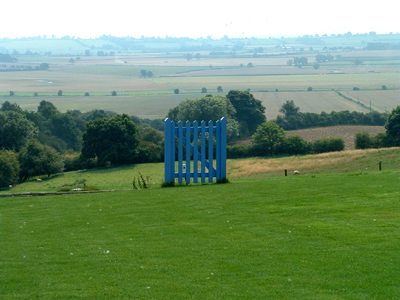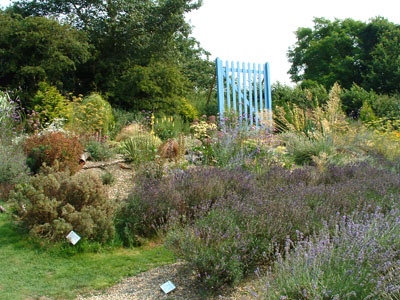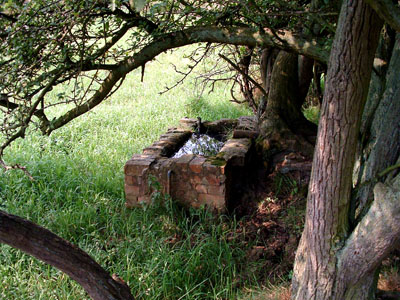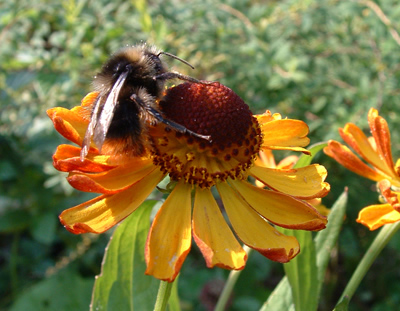August 25th 2005 - A day out with the ladies
A welcome day out last Wednesday, to Yorkshire Lavender in Terrington, a few miles north of York. The trip was organised by the Women’s Institute and one of their members, Sue, asked me along. I have to admit that I felt some initial reluctance. The WI has always associated itself in my mind with blue rinses, hats and being respectable. I was hesitant, but decided to go along anyway and see what happened.
"The WI has always associated itself in my mind with blue rinses, hats and being respectable"
We set off from Broughton village hall, 32 of us in a coach, and arrived at sunny mid-morning after driving through some of the loveliest landscape in England. Yorkshire Lavender sits on a hill side overlooking a panoramic view of the Howardian Hills Area of Outstanding Natural Beauty. A vast stretch of rolling hills, fields and woodland spreads out before you; it’s a view that you could gaze at for years. It made me want to stay there, to watch the land change through the seasons, and maybe see storms far off in the distance. Even though the day of our visit was hazy, the view was still stunning.
We started by sitting down for tea and biscuits (lavender biscuits, by the way – highly recommended) and I was introduced to some of the ladies of the WI. They proved to be lively, welcoming and very good company. I recognised the woman who runs the paper shop, the dispenser from the local surgery and various others recognisable from round and about. After our tea, we sat in the sun to listen to a brief talk, given by a nice gentleman whose name I never found out, about the nursery’s history and the many uses of lavender, and were then free to wander.

A blue gate looks towards the view
"There were hundreds of plants, all flowering beautifully in shades of purple, blue and white, giving off clouds of scent into the light warm breeze"
The nursery sits in a slight cleft in a hill and the lavenders grow well there on the sunny slopes in well draining soil. There were hundreds of plants, all flowering beautifully in shades of purple, blue and white, giving off clouds of scent into the light warm breeze. You were constantly enveloped in their perfume, so much so that it was almost soporific. Combined with the warmth of the sun, the bright colours of surrounding flower beds and the stunning panorama laid out below, it felt perfect.
At the top of one slope a dry garden has been established along the length of the slope. It looked promising, with bright colours and much foliage, and had to be the first port of call. A giant blue gate, leading nowhere, lures you to the top of the rise. The area was laid out with a gravel path meandering between two long beds, and bordered with logs. The plants themselves were also set in gravel, though of a different colour to the path. Heleniums, Sedums, Verbena bonariensis, Rudbeckias, Verbascums, Salvias, Artemesia, Achillea and grasses, to name a few, and all looking very healthy and comfortable, thank you very much. Even the huge Stipa gigantea (Golden Oats) with its long arching plumes hadn’t been bothered by being so high up, with not one bent stem, and looked quite stunning with the sun shining through its oat-like seed heads so that they flickered and shone in the light.

Another blue gate overlooks part of the dry garden
After a good look round the dry garden, Sue and I scrambled down through a steep grassy field, with clumps of trees at the bottom, to see what was there. We found hawthorns and elder growing together amongst tall tussocky grasses, and an ancient apple tree which had bonded with an old brick water trough.
"What a good place for sheep to live – trees, long grass, fallen apples and a trough of clear, glistening, cold water"
In our wandering about, we startled a number of sheep who ran into the trees and stared out at us from the shadows, though I think they were mainly surprised at having their privacy invaded rather than being truly offended. What a good place for sheep to live – trees, long grass, fallen apples and a trough of clear, glistening, cold water. No sound of roads or planes, just perfectly peaceful.

That water trough
Back at the nursery, having passed another, smaller, blue gate, a familiar atmosphere was evident, one connected with serious plant choosing: slightly tense but excited, frowning and thoughtful expressions, hands hovering over foliage, pots being picked up and put down again, everyone just on the verge of selecting the right plant to remember the day by. The agonising decisions were almost made – ‘This one or that one? Both? All of them? Oh, I don't know!’
I bought two pots of Rudbeckia ‘Goldsturm’ to brighten up the autumn beds at home; there were some in the beds already but a plague of slugs saw them off over a couple of warm nights. Plants bought, we piled back into the coach for the journey home, sitting with pots on laps or between our feet, slightly drowsy and dissecting the day quietly, the air filled with the warm scent of lavender.
Here at home, there is little sign of the publicised drought; the water butts have refilled regularly and have never run dry, we’ve had little need to water the garden and, except for a couple of dry weeks in July, the local lawns have stayed green. Of course, it’s possible that the plants in the garden are happier for being in better positions, or that some of them are more established and can cope better. To be sure of what’s going on, I shall get a rain gauge and start recording rainfall.
"Although some plants are starting to look tired by now, there is more to come."
Although some plants are starting to look tired by now, there is more to come. The Rudbeckias and Heleniums are just coming into their glorious fiery own and the Verbena bonariensis, which has seeded itself all over the place, is blossoming in that wonderful shade of purple. Sedum spectabile is starting to open its dark pink flowers and the Crocosmia, thuggish though it can be, is in full and beautiful swing.
There are Japanese Anemones opening at the back on one border and the Echinops ritro is producing its spiky blue globes. I cut back the Sidalcea yesterday and hope that there is still time for them to flower again before winter. Last year they were flowering until the first frosts arrived.

A bee enjoying the Helenium autumnale
Some of the grasses have yet to flower, too – Miscanthus, Molinia caerulea and two Pennisetums – so we should still have an autumn display to enjoy.
At the allotment, we have promised that this year will be different and we’ll get all the digging done over autumn and winter so that we’re ready for spring planting without needing to panic. It is admittedly quite a good sized plot and more than we’ve been used to in the past. 70m x 7.5m is a long stretch of digging when you’re doing it by hand and not using power tools, but I hope we can get it done this time. Go on, it’s good for you!
Up there a few days ago, we noticed a few molehills. We’ve never seen any there before and I hope they’re just passing through rather than setting up home. The hills had a lot of sand in them, as if the moles had come from deep down in the soil. They live on insects and invertebrates, mainly worms, like sandy soil and, although they can damage roots by their digging activities, they tend not to eat them. One more thing to keep an eye on.
Hmm, this has a bit long, hasn't it?
© Copyright Miranda Hodgson 2005